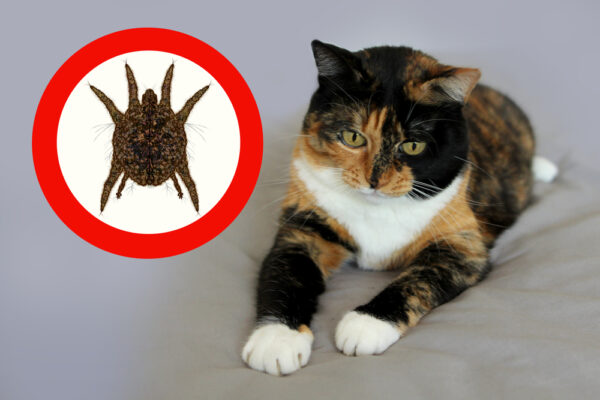
Ear Mites in Cats: Symptoms, Treatment and Prevention
Cat ear mites are a common and highly contagious issue. These tiny parasites can infest the ear canal, leading to discomfort and irritation for your furry companion. While they predominantly affect younger cats, ear mites do not discriminate based on age and can be a nuisance to cats of any life stage. Recognizing the signs of an ear mite infestation is crucial for any cat parent, as early detection can prevent more serious issues and ensure effective treatment.
Our Annie had ear mites when we adopted her. It was my first time experiencing cat ear mites. I am not posting a photo here because they are quite sickening but if you are curious you can easily find images with a quick search. Annie’s ear mites were treated and cleared up quickly. Eddie did not get the ear mites even though they are quite contagious.
Treatment for ear mites typically involves topical medications, though in some cases oral or injected medication might be recommended by a veterinarian. Maintaining good hygiene and regular vet check-ups can prevent ear mites from spreading and causing complications. Since ear mites can transfer between animals, it’s important for cat parents to be vigilant, especially if their cats interact with other animals. Identifying and addressing an ear mite infestation quickly will minimize the risk of transmission and health impacts on your cat and others.
Key Takeaways
- Ear mites are a prevalent and contagious problem in cats, affecting animals of all ages.
- Prompt treatment is essential to prevent complications and involves medication administered by a veterinarian.
- Prevention includes maintaining hygiene and regular health checks to protect the cat and other pets.
Understanding Ear Mites in cats

Ear mites, particularly the species Otodectes cynotis, are tiny parasites that colonize in the ears of cats, leading to irritation, potential infection, and discomfort for the affected animal.
Characteristics of cat Ear Mites
These tiny ectoparasites are barely visible to the naked eye and thrive in the ear canals of cats. They have a predilection for the wax and oils within a cat’s ear, where they cause intense itchiness. Ear mites are distinguishable by:
- Their size: small, about the size of a pinhead.
- The appearance of affected ears: an excessive buildup of dark, waxy debris resembling coffee grounds.
- Transmission: highly contagious, primarily through direct contact with infected animals.
ear mite Life Cycle and Reproduction
The life cycle of Otodectes cynotis proceeds through several stages:
- Egg: The female mite lays eggs in the ear.
- Larva: Eggs hatch into larvae within four days.
- Nymph: The larvae then develop into nymphs.
- Adult: Finally, these nymphs mature into adults capable of reproduction.
In complete, the cycle from egg to reproducing adult can occur in as little as three weeks, and during their life span, which can be up to two months, female mites can lay dozens of eggs. This accelerated and prolific reproduction makes swift treatment imperative to prevent infestation spread.

How To Check for Ear Mites in Cats: Symptoms of Infestation
Recognizing the symptoms of ear mite infestation in cats is critical for timely and effective treatment. The presence of these parasites often leads to noticeable discomfort and can cause a range of symptoms that are generally visible through a cat’s behavior and the condition of their ears.
Common Indications
Cats with ear mites typically exhibit intense scratching of their ears due to the itchiness caused by the infestation. They may also engage in frequent head shaking, as if trying to dislodge irritants from their ears. These behaviors are often the first signs noticed by pet owners.
Physical Signs
A closer examination of the cat’s ears can reveal further symptoms:
- Redness: The ear canal may appear red and inflamed.
- Discharge: A tell-tale sign is an abnormal ear discharge that resembles coffee grounds, which is a mixture of wax, blood, and mites.
- Wax Accumulation: Excessive dark and waxy discharge can be observed.
- Ear Canal Condition: There may be signs of infection or inflammation within the ear canal itself.

Diagnosis
When suspecting ear mites in cats, diagnosis by a trained veterinarian is crucial to managing and resolving the issue effectively.
Veterinarian Examination
The initial step in diagnosing ear mites is a thorough examination by a veterinarian. They will inspect the cat’s ear canals for symptoms such as inflammation, discharge, and the presence of mites. Typical signs that prompt a veterinary visit for a diagnosis include excessive scratching of the ears, frequent head shaking, and a noticeable black or reddish-brown discharge within the cat’s ears.
Diagnostic Tools
Veterinarians employ several tools to confirm the presence of ear mites:
- Otoscope: This is a primary tool used during the examination. It allows the veterinarian to look deep into the ear canal, where they can often see mites directly.
- Microscope: A swab sample of ear debris may be collected and then examined under a microscope to identify mites and their eggs with precision.
- Swab Test: Besides visually confirming mites, this test can also help rule out other ear conditions that may mimic the symptoms of ear mite infestation.
Applying these diagnostic approaches ensures an accurate identification of ear mites, leading to an effective treatment plan for the feline patient.
how to treat ear mites in cats: Treatment Options
Effective management of ear mites in cats involves a combination of medications and thorough cleaning. Veterinarians typically prescribe specific treatments tailored to eradicate these parasites and soothe the cat’s discomfort.
Medications and Applications
A range of medications is available for treating ear mites in felines. The most common ones include:
- Ivermectin: Administered as an injection or orally, Ivermectin can control the infestation by targeting the nervous system of the ear mites.
- Selamectin: Often found in topical treatments such as Revolution, Selamectin not only treats ear mites but also offers protection against a variety of other parasites.
- Ear Drops: Specific ear mite treatment for cats may involve the application of ear drops that contain Pyrethrin or other active ingredients designed to kill ear mites on contact.
Veterinarians might also recommend treatments that combine antiparasitics with anti-inflammatory medication to reduce the discomfort caused by mites.
Cleaning and Care
Cleaning is crucial in conjunction with medication to treat ear mites. The process usually includes:
- Ear Cleaner: Use a vet-approved ear cleaner to remove debris and discharge accumulated in the cat’s ear canal.
- Gentle wiping: After applying the cleaner, gently wipe away the loose material with cotton balls or gauze.
Cat parents should follow a vet’s instructions closely when cleaning their cat’s ears to avoid damaging the sensitive structures of the ear canal. Regular cleaning during and after treatment can also help prevent re-infestation.

Prevention and Management
Preventing ear mites in cats centers on consistent monitoring and maintaining a clean environment. Adherence to these practices can markedly reduce the risk of mite infestation.
Routine Checks
Routine checks of a cat’s ears are crucial for early detection and prevention of ear mites. Owners should perform a weekly inspection of their cat’s ears to look for any signs of mites, such as excessive scratching, shaking of the head, or dark debris resembling coffee grounds. Indoor cats may have a lower risk, but are not immune to infestations, especially if they come into contact with outdoor cats. For outdoor cats, more frequent checks are advisable due to their increased exposure to mites.
Environmental Control
Maintaining a clean environment is essential for ear mite prevention. Regular housekeeping minimizes the spread of mites within a household. A cat’s bedding should be washed routinely in hot water to kill any potential mites. While there are home remedies for ear mites in cats, such as olive oil or vinegar solutions, they are generally less effective than veterinary-prescribed treatments and their use should be discussed with a veterinarian. Vacuuming carpets and upholstery and treating other pets in the home can also reduce the risk of ear mite reinfection.
Complications and Risks
Ear mites in cats can lead to significant health problems if left untreated. Beyond the discomfort caused by the infestation, several complications can arise, including ear infections and additional health issues that can affect the cat’s overall well-being.
Secondary Infections
- Bacterial and Yeast Infections: The incessant scratching and head shaking from ear mites can lead to the breaking of skin within the ear, creating an environment ripe for bacterial and yeast infections. These infections require their own specific treatments.
- Aural Hematomas: Excessive scratching can also result in blood vessels within the ear flap breaking, and this often results in an aural hematoma, a condition that may need to be resolved via surgery.
Associated Health Issues
- General Irritation and Inflammation: The persistent irritation and resultant inflammation from ear mite infestations can lead to chronic discomfort and stress in cats.
- Overall Health Impact: An untreated infestation and the resulting complications can impact a cat’s general health, leading to lethargy and a decrease in quality of life.
Impact on Other Pets
Ear mites in cats are a common issue that can significantly affect the health and comfort of other pets in the household. Due to their highly contagious nature, ear mites can be transmitted from cats to various other animals, including dogs. Any symptom of ear mites, such as persistent itching in the ears, should prompt owners of multi-pet households to consider the implications for each pet.
Contagious Nature
Ear mites are extremely contagious among animals. They are usually transmitted through close physical contact. This means that if one pet in the home has ear mites, others are at risk. Dogs, for instance, can contract Otodectes cynotis, the mite responsible for ear mite infestations in cats, though cats are more commonly affected than dogs. Other animals that may be at risk include rabbits and ferrets.
- Transmission: Direct contact, such as playing or sleeping together
- Mites Visible: Rarely to the naked eye
Treatment for Multi-Pet Households
When a multi-pet household is dealing with an ear mite infestation, treatment should be approached collectively. All affected pets should be treated simultaneously to prevent reinfestation. Additionally, an environment free from ear mites should be ensured, which includes thorough cleaning of bedding and living spaces.
- Simultaneous Treatment: Essential to prevent cycle of reinfestation
- Environmental Cleaning: Includes bedding, furniture, and any shared pet spaces
Treating all animals at the same time halts the spread and gives each pet the chance to recover without the risk of catching ear mites again from untreated companions.

Considerations for Specific Groups
In addressing ear mite infestations in cats, certain groups require tailored consideration due to their life stage and health status.
Kittens
Kittens are highly susceptible to ear mites, often contracting them from their mothers during nursing. Symptoms may be more pronounced in these young cats and can include intense scratching and potential hair loss around the ears. Immediate and gentle treatment is crucial to prevent the mites from causing lasting damage to the ear canals.
Senior Cats
Senior cats, with their potentially compromised immune systems, may exhibit a more severe reaction to ear mite infestations. They require swift veterinary intervention to mitigate symptoms and manage any secondary infections that can arise. Regular ear checks are important for elderly felines to ensure early detection and treatment.
Advanced Treatments
The management of ear mites in cats has seen promising progress with both surgical and alternative methods proving to be effective. These treatments are considered when conventional therapies do not yield the desired results and are tailored to the severity and complexity of the infestation.
Surgical Interventions
Surgical options are often a last resort, typically considered when a cat develops secondary conditions such as an aural hematoma. This condition occurs when consistent scratching and head shaking lead to the rupture of blood vessels within the ear, which can result in swelling and pain. In such cases, surgery might be necessary to repair the damaged vessels and alleviate the cat’s discomfort.
| Condition | Surgical Solution | Description |
|---|---|---|
| Aural Hematoma | Drainage and Suturing | Removes the collected blood and prevents recurrence through suturing techniques. |
Alternative Therapies
Alternative treatments may include the use of natural oils that exhibit miticidal properties. Although not a replacement for veterinary-prescribed medications, these therapies can serve as a supplementary measure.
Mineral oil often forms an integral part of the ear mite management routine. By incorporating mineral oil into the treatment plan, it helps to smother ear mites, thus easing the discomfort caused by the infestation. Meanwhile, coconut oil is known for its soothing properties and its potential to reduce inflammation and itchiness associated with the ear mites.
- Mineral Oil: A few drops applied into the ear canal can suffocate ear mites.
- Coconut Oil: Its anti-inflammatory property offers relief from irritation.
Understanding Related Conditions
Ear mites in cats can lead to secondary conditions that may complicate diagnosis and treatment. Key considerations include distinguishing between allergies and other ear problems, as both can exhibit similar symptoms such as redness, itchy ears, and rashes.
Recognizing Allergies
Cats with allergies may exhibit symptoms similar to those caused by ear mites, including itchy ears and redness. Allergens such as pollen, mold, or certain foods can trigger an allergic reaction, resulting in a rash or dermatitis. To differentiate an allergy from an ear mite infestation, veterinary testing and a close examination of the ear discharge are typically necessary.
Comparing Ear Problems
Various ear problems can mimic the signs of an ear mite invasion but have different underlying causes. For instance, bacterial or yeast infections can lead to ear discomfort and discharge. A vet can take a swab of the ear discharge and inspect it under a microscope to determine if mites, bacteria, or yeast are present. It’s crucial to correctly identify the root issue since the treatment for ear mites differs significantly from treatments for infections or allergies.

Frequently Asked Questions
When a cat has ear mites, they exhibit distinct symptoms that require specific treatments. Understanding these signs and the correct course of action can protect your cat’s health and prevent the spread of mites.
What are the symptoms that indicate my cat may have ear mites?
A cat with ear mites may frequently shake its head and scratch its ears. They often have black or dark brown ear discharge that resembles coffee grounds and may display signs of ear redness and inflammation.
How can I safely treat my cat’s ear mites at home?
Treating ear mites at home involves cleaning the ears with a gentle veterinary-approved ear cleaner and applying prescribed anti-parasitic medications. A veterinarian should always be consulted before starting treatment to ensure safety and effectiveness.
Is there a one-time treatment available for ear mites in cats?
There is no single treatment that can guarantee elimination of ear mites in all cases. A veterinarian may prescribe a series of treatments including topical medications, injections, or ear drops to fully eradicate the mites.
Can ear mites in cats be fatal if left untreated?
While not typically fatal, untreated ear mites can lead to serious complications like secondary infections and long-term ear damage. It is crucial to treat ear mites promptly to avoid these issues.
How can ear mites be distinguished from other ear infections in cats?
Ear mites can be distinguished by the presence of dark, crumbly discharge and intense itching. A veterinarian can confirm the diagnosis under a microscope as other ear infections may present similar symptoms but require different treatments.
Are humans at risk of contracting ear mites from their feline pets?
Humans are typically not at risk of contracting ear mites from cats. These parasites are highly adapted to their animal hosts, and cross-species transmission is very rare.